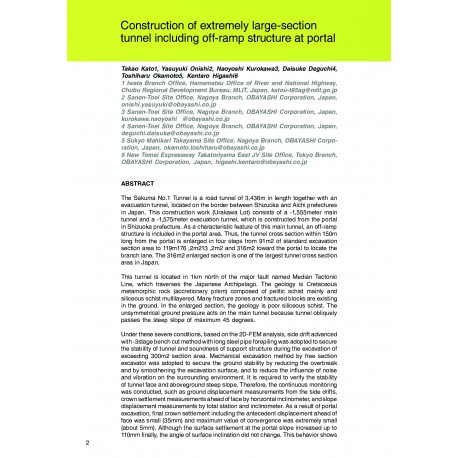Cart
0
0
No document
0,00 €
Total
Document successfully added to your shopping cart
Quantity
Total
There are 0 items in your cart.
There is 1 item in your cart.
Total documents
Total shipping
To be determined
Total
Search & filter
Search for a publication
Search & filter

Construction of extremely large-section tunnel including off-ramp structure at portal
3484_construction_of_extremely_l
T. Kato / Y. Onishi / N. Kurokawa / D. Deguchi / T. Okamoto / K. Higashi
The Sakuma No.1 Tunnel is a road tunnel of 3,436m in length together with an evacuation tunnel, located on the border between Shizuoka and Aichi prefectures in Japan. This construction work (Urakawa Lot) consists of a -1,555meter main tunnel and a -1,575meter evacuation tunnel, which is constructed from the portal in Shizuoka prefecture. As a characteristic feature of this main tunnel, an off-ramp structure is included in the portal area. Thus, the tunnel cross section within 150m long from the portal is enlarged in four steps from 91m2 of standard excavation section area to 119m176 ,2m213 ,2m2 and 316m2 toward the portal to locate the branch lane. The 316m2 enlarged section is one of the largest tunnel cross section area in Japan.This tunnel is located in 1km north of the major fault named Median Tectonic Line, which traverses the Japanese Archipelago. The geology is Cretaceous metamorphic rock (accretionary prism) composed of pelitic schist mainly and siliceous schist multilayered. Many fracture zones and fractured blocks are existing in the ground. In the enlarged section, the geology is poor siliceous schist. The unsymmetrical ground pressure acts on the main tunnel because tunnel obliquely passes the steep slope of maximum 45 degrees.Under these severe conditions, based on the 2D-FEM analysis, side drift advanced with -3stage bench cut method with long steel pipe forepiling was adopted to secure the stability of tunnel and soundness of support structure during the excavation of exceeding 300m2 section area. Mechanical excavation method by free section excavator was adopted to secure the ground stability by reducing the overbreak and by smoothening the excavation surface, and to reduce the influence of noise and vibration on the surrounding environment. It is required to verify the stability of tunnel face and aboveground steep slope. Therefore, the continuous monitoring was conducted, such as ground displacement measurements from the side drifts, crown settlement measurements ahead of face by horizontal inclinometer, and slope displacement measurements by total station and inclinometer. As a result of portal excavation, final crown settlement including the antecedent displacement ahead of face was small (35mm) and maximum value of convergence was extremely small (about 5mm). Although the surface settlement at the portal slope increased up to 110mm finally, the angle of surface inclination did not change.


